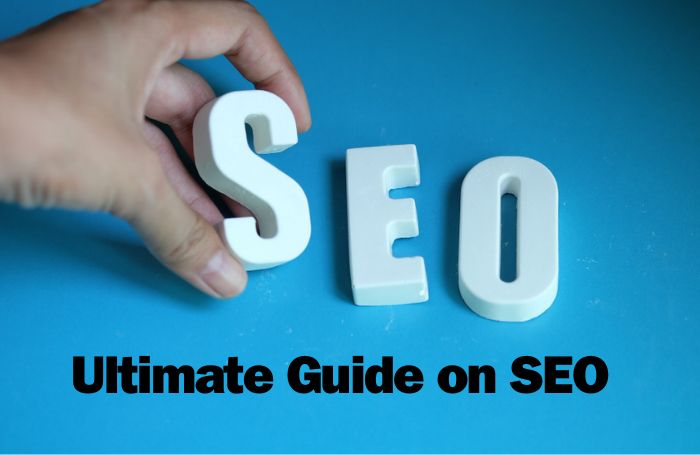
Attracting customers’ attention to your company isn’t easy without a website or other online presence. Customers nowadays anticipate being able to get to a company’s website and confirm its legitimacy, regardless of whether they have only ever seen it in a physical store.
Since every company is vying for the attention of online shoppers, the digital arena is very cutthroat. Your website has to rank well in search engine results when people are looking for the goods or services you provide if you want to attract clients, beat out the competition, and make money. This is where partnering with a digital marketing agency can make a difference—search engine optimization (SEO) is essential in this regard, and experts can help you succeed.
What is SEO?

SEO is a broad phrase for optimizing website pages to enhance organic (non-paid) search engine traffic. Simply put, this involves making sure search engines are aware of your website, that people can discover what they’re searching for and have a positive experience, and that search engines identify high-quality sites.
SEO is complex, challenging to understand, and an active and ever-changing process, not a one-and-done task. To keep up with the ever-changing search landscape, the word SEO encompasses many techniques. SEO tries to make your website pages seem reasonable to your target audience and attract the proper searchers. This should give you an edge over the competition and increase conversions and customer loyalty.
How does SEO Work?
Search engines now provide answers to almost all inquiries. You can get the solution to anything by typing it into Google, which returns an unending number of search results. But how does that function?
Crawling is the procedure that all search engines employ to provide you with results. Crawling sends search engine crawlers to all sites the engine knows to retrieve data from them. Search engines can index web pages via this approach.
After adding a page to the index, an algorithm matches its data to search engine queries. Google considers various additional factors when ranking websites.
- Off Page – The use of backlinks on the site is a significant component of these metrics that Google measures.
- On Page – A strong correlation exists between the number of keywords and information searches discovered on a site and its on-page ranking.
- Technical – In the end, metrics that decide a page’s ranking are more concerned with site-wide performance metrics and less with specific page metrics.
More high-quality content on your website improves search engine rankings. This material must be organized to emphasize your company’s value to prospective customers while providing search engines with the information they need to understand your business and site visitors’ demands.
Importance of SEO
SEO is crucial for companies for several important reasons:
- Organic Traffic Growth – High search engine rankings attract more natural or unpaid visitors. This concentrated traffic involves users actively seeking the company’s products or services.
- Competitive Advantage – Investing in SEO gives firms a leg up in today’s digital market. Gaining more exposure and market share is possible when your website ranks better than your rivals.
- Improved User Experience – Faster page loads, mobile friendliness, and easy navigation are a few examples of how SEO improves the user experience on a website. Users are more engaged and satisfied as a result of this.
- Adapting to New Trends – SEO needs constant monitoring of search engine algorithm updates and industry trends. To be relevant and competitive, organizations need to adapt to these developments.
- Efficiency in Cost – SEO takes a long view, unlike sponsored ads. Websites may continue to get organic traffic if they reach higher positions, eliminating the need for continued advertising costs.
- Greater Rates of Conversion – Conversion rates for targeted organic traffic are higher. People farther along in purchasing often visit websites that appear in organic search results.
- Reliability and Trust – Users tend to have a more favorable impression of websites with better search engine rankings. Business reputation and brand value might benefit from this.
- Extended Outcomes – After the original optimization work, well-conducted SEO efforts may still provide long-lasting effects. A well-optimized website may preserve search engine rankings.
- Visibility in Local Search – Using local SEO, brick-and-mortar companies may increase their visibility for related goods and services in local search results.
- Data-Based Understandings – SEO is a great way to learn about user behaviors, search patterns, and how well certain keywords are doing.
About EEAT
Experience, Expertise, Authoritativeness, and Trustworthiness are the four pillars upon which EEAT rests. Google uses this methodology to determine how good a website’s content is. An integral part of Google’s search algorithm, EEAT helps decide which websites should have better search engine rankings depending on the quality and trustworthiness of their content.
Workers there, known as Quality Raters, use these remarks to help figure out whether search engine results provide relevant, excellent data. Web admins may be certain that their content is up to Google’s standards for quality and relevancy if they follow the EEAT guidelines when publishing online. However, these guidelines should not be mistaken for direct ranking signals.
How Search Engine Works?
Knowing the inner workings of the search engine and ensuring that you are sending the correct signals to affect visibility are prerequisites to having people discover your company via search, regardless of platform.
Searching on standard online search engines such as Google has four stages:
- Crawling – Search engines rely on crawlers, which navigate the web via links and sitemaps, to find websites.
- Rendering – The markup languages search engines use to determine a page’s appearance include HTML, JavaScript, and CSS.
- Indexing – Although not all of your website’s pages will get indexed, search engines examine the contents and metadata of the pages they find and add them to a database.
- Ranking – To decide if a website is relevant and of sufficient quality to display when users input a query, complex algorithms examine several signals.
What is SEO Strategy?
An SEO marketing strategy is an all-encompassing approach to increase website traffic from search engines. Successful SEO comprises on-page campaigns using intent-based keywords and off-page campaigns that gain inbound links.
Search engine optimization includes improving technical website setup, content, and linkages. Let’s go over them one by one.
Technical SEO
Regarding search engine optimization, technical SEO is all about the nuts and bolts. It entails ensuring that a website’s backend components, code, and structure are organized and suitable for search engines. Some technical aspects of SEO include mobile friendliness, site architecture, site performance, schema markup, canonical tags, and XML sitemaps. Among the most crucial elements impacting it are:
URL Structure
Uniform Resource Locator is when you see the acronym URL. URLs favorable to search engines are recommended since they aid in understanding the site’s content. A vital SEO concern is the URL structure, which might lead to worse rankings for your website.
Page Speed
One measure of a page’s quality that search engines consider is its load time, or how long it requires for a user to see the content. It is affected by several aspects of the webpage—for instance, picture dimensions. To get advice on how to make your pages faster, use Google’s Page Speed Insights Tool.
Broken Links
An empty page is what a dead link refers to. A resource that was redirected to an invalid URL may have since disappeared. Neither of these options is suitable for users, and they hinder search engines from crawling your site.
Sitemap & Robots
A sitemap is a text file that catalogs every URL on your website. It tells search engines which pages to index and crawl. However, you may instruct search engines not to index certain pages—like your policy pages—by adding them to a robots.txt file. Get both done at once to make your material more crawlable and indexable.
AI & Duplicate Content
Search engines are confused when pages with similar or identical information are found. Most of the time, they have a tough time showing any of those pages. Your website can face penalties from search engines if they detect them. Because of this, search engines see duplicate material negatively.
Content
When you use a search engine, you seek material about a subject or concern. This is available in many forms. A blog post or web page might be an example of text. However, it may also be a movie, a suggestion for a product, or even a listing for a company. All of it is content. Conducting keyword research is the first step in optimizing content.
Keyword Research
SEO is not about increasing site traffic. Your goal should be to draw in potential leads and, eventually, consumers who genuinely need your product or service. That is, if it achieves a high search engine ranking for the terms individuals use. If you don’t, they’ll never be able to locate you. It is assuming, of course, that your website was to rank well.
That’s why finding out what people are searching for online is the first step in search engine optimization. Finding industry-specific words and phrases is a common first step. Next, we’ll turn them into first-stage keywords. And lastly, digging deep into the subject to find relevant words your target demographic would utilize.
For those new to keyword research, there is an extensive guide available. It describes the steps to take while doing keyword research. Find out what search phrases you need to focus on by using it. Optimizing your content comes after compiling a list of keywords. In the field of SEO, this is called on-page optimization.
On-page Optimization
Search engines can better analyze and match pages with relevant content when on-page optimization, also known as on-page SEO, is implemented—page, not substance. The reason is that optimizing some code parts is part of on-page SEO, even if most of it is focused on the words you use. Some of these may be familiar to you; the most common are meta-tags, titles, or descriptions. But that’s not all.
Feature Snippet
Get your content highlighted snippets so that voice assistants may read it aloud. Arrange your material so that it offers concise and understandable responses.
Keyword Optimization
Web analysts and SEO experts say enhancing on-page content for target keywords is the greatest SEO strategy for SERPs. Before optimizing a page, Google should know the keywords you wish to rank for. To do it, use the following, making sure to include the primary keyword:
- Title of the post – Put it as near the beginning of the title as possible. The first few words of a headline are believed to have greater weight with Google.
- URL – Use the term in both the page’s URL and title. Ideally, excluding all other items. Get rid of any stop words as well.
- H1 Tag – This element automatically displays Page titles in most CMSs. Be cautious, nevertheless, as your platform may employ an alternative configuration.
- First hundred words (or the first paragraph) of the content – Search engines like Google will be more comfortable with your blog article if you include the term right at the beginning.
- Meta-title and meta-description tags – Search engines display listings using these two codes. Search results utilize the meta-title as the title and the meta-description as the brief text below it. However, they use both to explore the page’s topic.
- ALT tags and file names of images – Do you recall how that search engine interprets images on a website? All they can see are the names of their files. So, check that the file names of a minimum of one of the photos include the keyword.
Non-Keyword-Related On-Page Optimization Factors
Using keywords liberally is just part of on-page SEO. The following also contribute to verifying the legitimacy and authority of a page:
- External links – Google can learn more about your issue by linking to other related sites. It also offers a pleasant experience for the user. In what way? Through establishing your material as an invaluable asset.
- Internal links – You may increase your rankings in two ways using those connections. For starters, they make it easier for search engines to index and browse your site. Second, they indicate semantic links between pages, improving search query relevancy. Every blog article should typically include two or four internal links.
- Length of the content – Content that is longer tends to rank higher. A well-written, lengthy blog article will always provide more information on the issue, keeping readers on your site longer. The search engines consider dwell time when determining a page’s rating.
- Multimedia – Videos, diagrams, and audio players are not necessary but may indicate a high-quality website. Like lengthier content, it holds readers’ interest for longer. And that’s a good indicator because it means they think the information is worthwhile.
Links
So far in this guide, you have learned that relevance and authority are necessary for a page to rank. Google and other search engines emphasize popular, relevant sites to provide consumers with the most accurate responses. Technical setup and content centered on relevance (but some of these aspects may also indicate authority.) But links are what make a site popular.
What are Backlinks?
When other websites connect to your material, it’s a link or a backlink. A backlink indicates that another website has referenced and linked to your content. Google considers the amount and quality of these links to indicate a website’s authority.
Webmasters are likelier to link to a renowned and excellent site than a substandard one. Pay attention to the quality of the links, too. The reason is that different connections have different purposes. Some of them, especially low-quality ones, might hurt your search engine results.
Link Quality Factors
If you artificially use low-quality or dubious links to boost a site’s authority, Google may lower your ranks. SEOs focus on quality links rather than quantity. In doing so, they want to provide references of the greatest quality.
Like the search algorithm, you have no idea what exactly plays into a link’s quality. Some of them, nevertheless, were eventually uncovered by SEOs:
- The linking site’s popularity – Links from authority domains are inherently high-quality. Higher-quality connections from other websites will provide better results.
- Relevance of topic – Domains that link to you from related topics will have more weight than websites that link to you at random.
- Credibility in a domain – Search engines also consider how trustworthy a website is, similar to how they think of popularity. Better search engine rankings are always the result of links from more reliable websites.
Link Building
Getting new backlinks is known as link building in search engine optimization. Many people who work in the field will tell you that it isn’t always easy. You must be patient, strategic, and creative to succeed at link-building. Create a link-building strategy if you want to get high-quality links. And it’s certainly no easy task.
You need to ensure that your connections meet several quality standards. Additionally, search engines may not realize you constructed them intentionally. Here are a few ways to do it:
- Editorial and organic links – Websites that connect to your material from their resources are called backlinks.
- Outreach – You reach out to other websites to get links. This is possible in several ways. One option is to write some remarkable content and then notify them via email. Then, if they think it’s useful, they’ll mention it. The location you think they should connect to it is also up to you.
- Guest posting – What you write for your blog and have published on other websites is called a guest post. In exchange, you can usually get such firms to let you link to your website in the author profile and content.
- Links to profiles – A lot of websites let you build a link. An excellent example would be online profiles. When creating a profile, you may often include your website. Some connections have authority, but not all. Due to their clarity of creation, they’re worth exploring.
- Competitive analysis – A large number of SEOs routinely research the backlink profiles of their rivals to replicate the success they’ve had.
Those who are still here have found what makes your site searchable. The next stage is to determine the efficacy of your efforts.
How to Track SEO Results?
Having well-optimized technical elements, content, and links is essential for a website to appear in search engine results. You may refine your approach by keeping tabs on your progress. A website’s engagement, links, and traffic may be measured to determine an SEO campaign’s performance. Here are some of the most typical SEO KPIs, while most organizations create their own sets:
- Expansion of organic traffic.
- Rankings for keywords (separating branded from non-branded phrases).
- Conversions resulting from organic traffic.
- A measure of how long users spend on a page, including the bounce rate.
- Leading landing pages drawing organic traffic.
- The number of pages that have been indexed.
- Links growth, includes both the new and lost links.
How to Track Google Algorithm Update?
You may be asking how to follow algorithm changes when they’re published. Some tried-and-true methods and strategies are at your disposal:
Google Your Voice
For optimal results, Google is constantly tweaking its algorithm. Consequently, you should know the requirements for ranking (and ranking effectively). Doing so requires knowledge about Google’s priorities for enhancing the user experience. Among these elements are:
- Superior, relevant, original, and SEO-enhanced content.
- Websites designed to provide a pleasant experience for users.
- Sites that provide the most relevant response to a search.
- Trusted recommendations from other pages on the web.
Monitor Web Traffic/Search Ranking
Keeping up with Google’s regular changes is possible in several ways. One strategy is frequently monitoring your site’s analytics data and keyword rankings. You can see how search engine results page (SERP) measurements change over time on a graph. Compare the two data sets to look for trends in the previous 30 days.
Identifying essential changes will help you monitor upgrades and assess their effect. It lets you determine how the change affected you and whether to respond.
Create a Google Alert
A straightforward approach to keep up with algorithm changes is to set up a Google alert. One may personalize notifications according to the following:
- Topic
- Phrase
- Frequency
- Quality
- Source
This method for catching up with Google algorithm updates is best since the news arrives at your door without any activity required.
Keep Up with The Latest
Several excellent SEO sites cover all sorts of search changes. To stay abreast of Google’s algorithm changes, here are a few tools you may use:
- Google Webmaster Central Blog
- Industry Leaders
What are SEO Tools?
Google does not believe any third-party program that tracks algorithm updates. Some Google representatives have advised SEO practitioners that such tools are often misleading. While SERP changes aren’t usually the consequence of an update, observing them may offer early notice of an upgrade.
Some useful tools for tracking Google algorithm modifications and understanding how they affect organic traffic are:
- Algoroo – A greater number for the roo, the tool’s indicator for measuring volatility, indicates more risk.
- MozCast – There is instability in the Google algorithm, as seen in a weather report. There is greater algorithmic flux when the weather is hot and stormy.
- SEMrush – One of the finest algorithm monitoring tools for 30-day SERP volatility by device and location.
- CognitiveSEO Signals – Monitor more than 100,000 terms daily and get alerts if Google is acting erratically.
- Penguin – Free SEO tool to check whether an algorithm change has damaged your ranking.
Local SEO
Google also allows you to target local clients with your company. But local SEO is what you need for that. Plus, it’s money well spent.
Nearby companies appear in 46% of all Google searches. They scour the web for recommendations from vendors and even addresses of certain companies. When looking for a local company, 87% of customers utilize Google, they want vendor recommendations and company addresses.
Wait a second, isn’t what we’ve discussed here the same as local SEO? Somewhat, yes. Both domestic and international search engine rankings are based on the same basic concepts. However, they must also consider other ranking elements because they rank sites for location-based results.
You can see the difference even in local search results:
- Your search results will only include them if you have a local purpose (such as a restaurant near me or when you explicitly specify the location).
- They include findings that are location-specific.
- The primary focus is on providing consumers with targeted information that can be found elsewhere.
- Since local searches are increasingly done on mobile devices, they aim their marketing efforts at smartphone consumers.
- Local packs, the most visible feature of local results, provide practically all the information consumers need to pick a company. When you search for the best restaurant in Cambridge, Google returns these local results.
Conclusion
Before you even think about what SEO is, you need a plan to make your website stand out from the millions of others online. You may become an SEO expert with the aid of SEO from the very first day.
Learn all there is to know about search engine optimization (SEO), from researching and managing keywords to optimizing pages on and off-site, creating links and URLs, and analyzing your results. You’ll also gain valuable project experience that will help you regulate inbound marketing campaigns.














[…] 100 mg sildenafil price […]